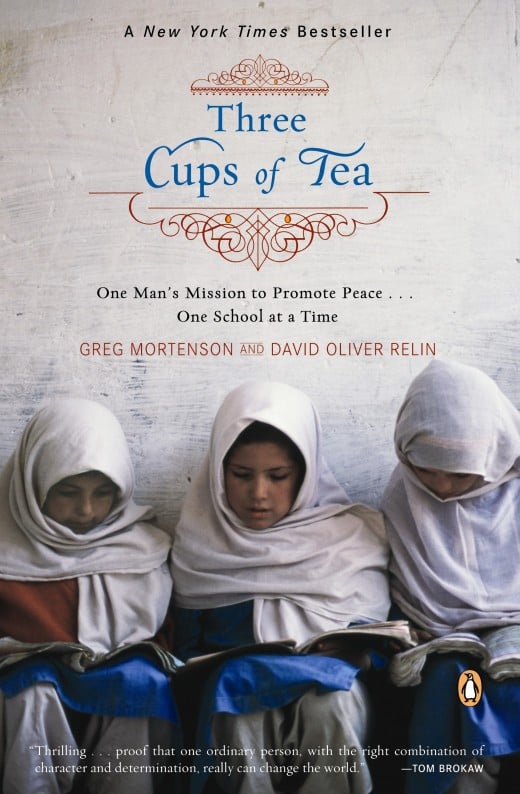Three Cups of Tea Response Essay
Book Cover

Three Cups of Tea Response Essay
The novel Three Cups of Tea, written by Greg Mortenson and David Oliver Relin, is the story of the true life adventure Greg Mortenson experiences. Mortenson’s adventure takes place in Pakistan and Afghanistan, specifically a northern Pakistan region known as Baltistan. The story begins with Greg Mortenson attempting to climb K2, the second largest and arguably the most difficult and deadly mountain in the world. In his disaster prompted early descent, he gets lost and ends up in a small village called Korphe. They nurse him back to health and help him find a way home. He is moved by the kindness of the villagers and vows to return to build a school for them. This book is the story of his struggles to build a school for Korphe, and hopefully give them the education they lack.
“Greg is not one of us” (p. 4) says his wife, which is completely true when understanding his personality. Words that immediately jump to mind when thinking of Greg include compassionate, loving, and devoted. His adventure started when he ventured to K2 to attempt to reach the summit in honor of his sister. He had helped his sister Christa maintain an independent lifestyle after she contracted meningitis as a child and never fully recovered. She died from a massive seizure on her 23rd birthday. This is a reason enough to describe this man as loving, but he proves these qualities again and again throughout his adventure. Before he is able to reach the summit, another climber is injured after climbing up too fast and not acclimating to the altitude. He must turn around and help him down, 600 meters from the summit. He could have kept going and probably reached the summit, but because of his undying compassion for others, he turns around to help the injured climber. On his way down he becomes disoriented and strays from the trail and ends up miles away from where he should be. He stumbles into the village of Korphe, and is helped by the villagers. He sees the children scribbling school work into the dust with sticks, and because they helped him, he wants to help them in return. He vows to return and build them a school because he is a compassionate person.
Greg ultimately realizes that building this school will not only give these poor villagers the skills they need to succeed, but in the process that they can make a dramatic difference in the world. He observes the schools build by extremist terrorists that brainwash youth into believing their only purpose in life is to overthrow the infidels of the world, and decides that the only way to combat these Madrassas is to build schools that give an equal and unbiased view to both boys and girls. As if putting into action the idea of building these schools was not difficult enough, the challenge of actually doing it proves much harder than Greg originally thought. In order to get supplies to Korphe, he must first build a bright to move the supplies in. When the bridge is complete he sees how this seemingly meaningless improvement, which most if not all Americans would take for granted, greatly affects the lives of the villagers, especially the women. It gives them a sense of freedom that they never had before, because before they were restrained to their village and no world outside of it existed to them. When the school is eventually complete (after months of difficultly actually getting the supplies to Korphe), Haji Ali (the nurmandhar of Korphe) helps him plan future schools in other villages. Through this process Haji Ali becomes Greg’s advisor in Pakistan.
Greg changes so much throughout the book, but not as most readers would expect or notice. As with every story you expect the reader to undergo change all for the better, which in the majority of the cases true for Greg with a few exceptions. He is forced to sell his climbing equipment in order to fund his initial trip back to Pakistan. This is a change, where Greg feels he is giving up a lifelong partner, and it pains him to separate from climbing which he loves. He also sells his car which he had slept in for months to save money before departing for Pakistan. Later in the story we realize that because Greg was forced to give up climbing, he has become out of shape and lost his athletic figure. This is a negative change in his life. He also frequently is separated from his family for extended periods of time. Although his wife knows this is the marriage she agreed to at the beginning and understands this is what Greg must do, it is still difficult for her to put up with day after day, week after week, and in some cases, month after month. Amongst all these negative changes Greg undergoes, we the reader are able to pick out some more positive qualities Greg picks up along the way. It was his care for his sister who set his adventure in motion, and his continued care and sense of responsibility which led him to build these schools. His kindness grew with each school he built, which was a positive change he underwent.
My favorite part of the book is when his original sponsor Jean Hoerni was able to see pictures of the schools which he sponsored, tacked up next to his hospital bed. He was able to find a sense of life fulfillment as he lay dying in his hospital bed with leukemia. He even calls his old childhood friend before he passes away to brag about what he accomplished. In his will, he left an enormous sum of money to C.A.I. which allowed Greg to continue building schools, but now instead of just in his sister’s memory, also in memory of Jean. The story is moving because it made me believe that each and every life is significant, and somehow, although it may not seem possible because of difficulties with wealth or status, it is possible to change the world. I believe that a good way to summarize Greg’s entire mission would be, “The first step is always the hardest to take”, because it took him so much time and effort to build his first school, but once he had completed it, the others began springing up.
This book is completely relevant in our morality and social justice class because it shows making moral decisions extends beyond holding the door open for someone, or writing thank you cards after receiving gifts. It shows that we were all born with the ability to see a problem and be able to fix it, and to be the change we want to see. The only weaknesses which I can label this book with include the following: I believe that many people would be scared away from reading this book because of its length, and throughout the book parts are dragged on which could have been summarized in a way which does not take away from the story. Other than the listed weakness, this book has many strong points, including of course, it is a true story, the characters all have strong personalities and are very moving, and the story is exciting and keeps the reader wanting to know more. I would recommend this book to others, and although I was forced to read it I enjoyed it and would put it in the higher end of my favorite books I have read.
I did not write this book nor do I claim to own any part of it. This report was written as a school project and has been submitted to anti-plagiarism sites such as www.turnitin.com. Please use this only for reference and do not use this essay in its entirety and claim ownership.








